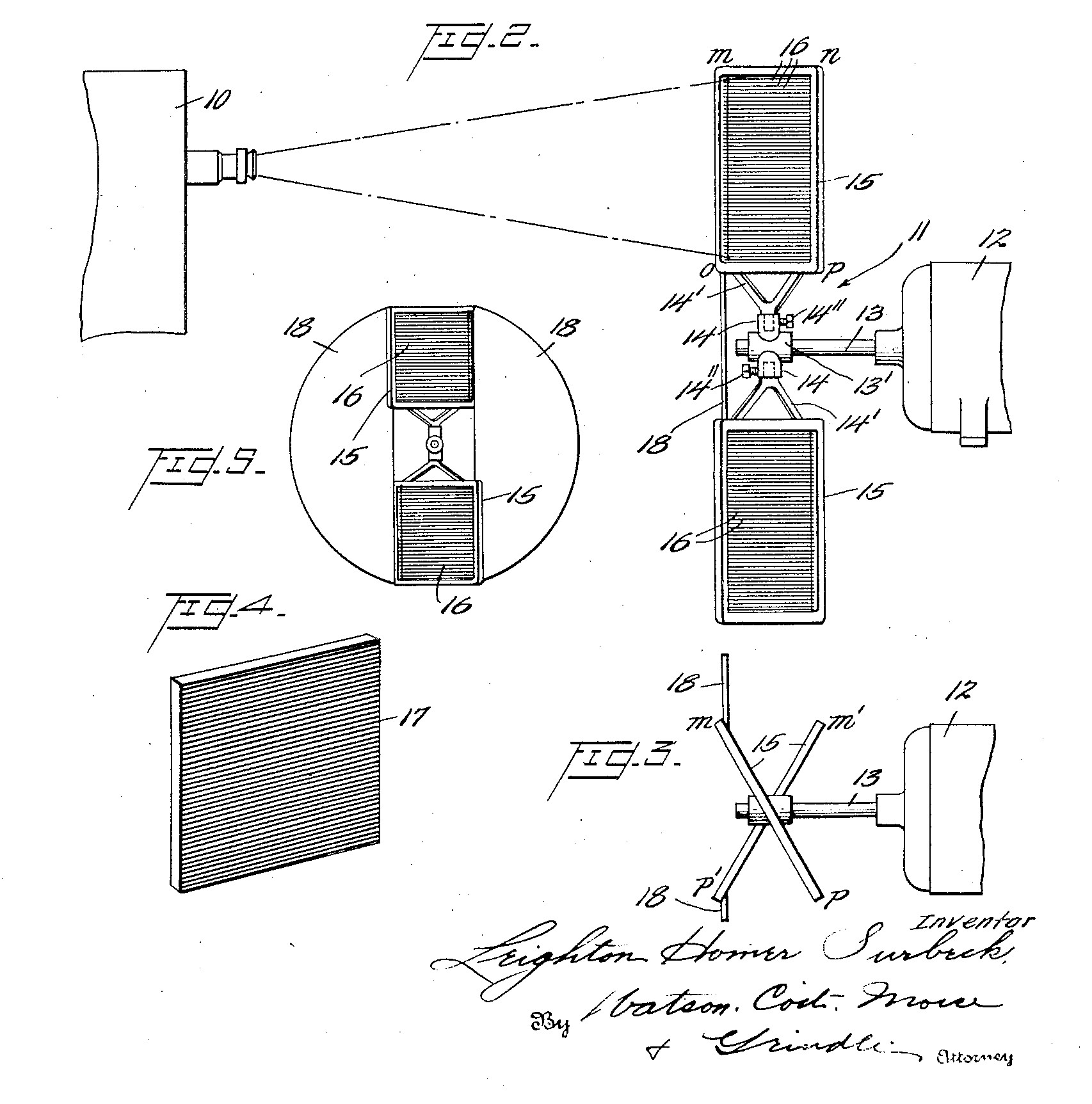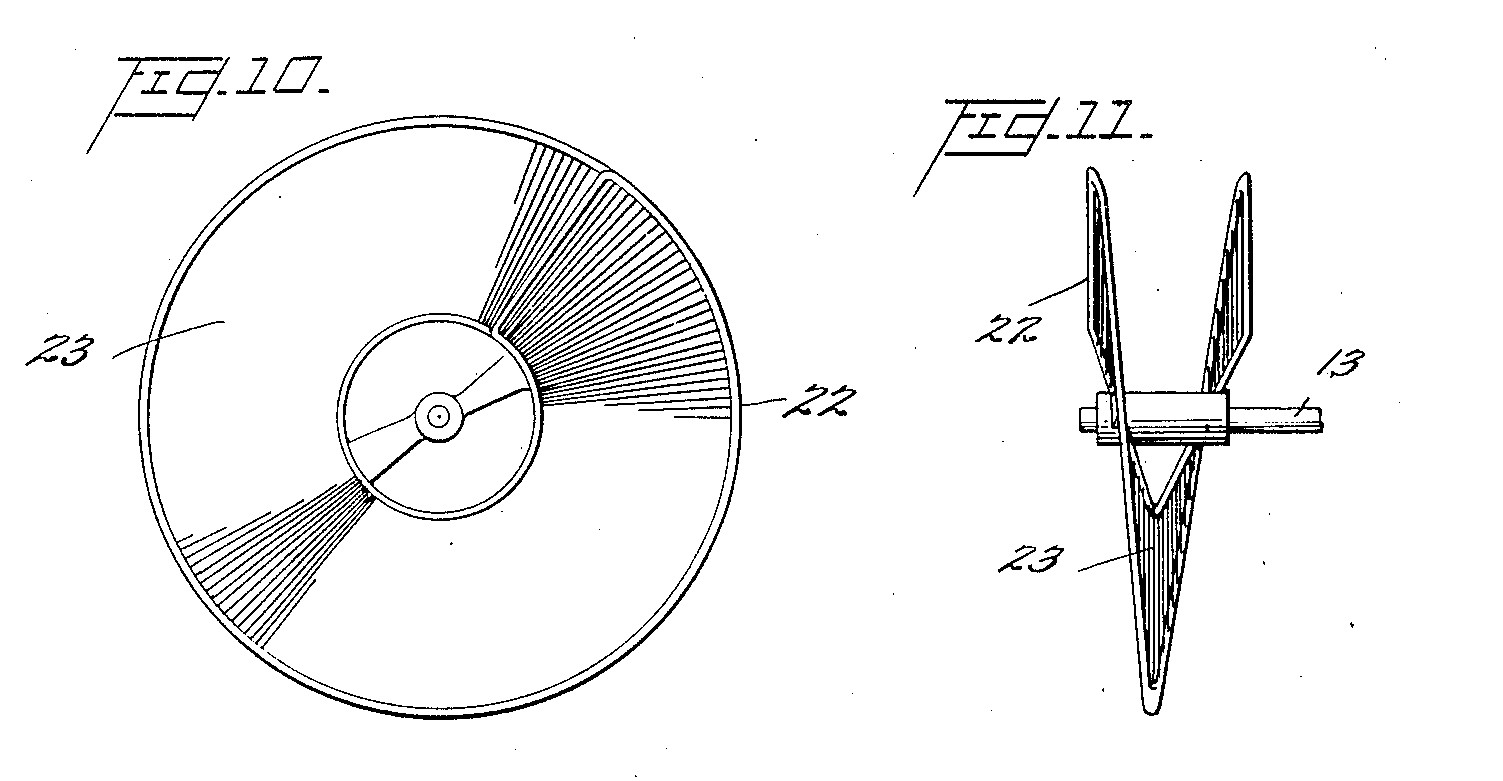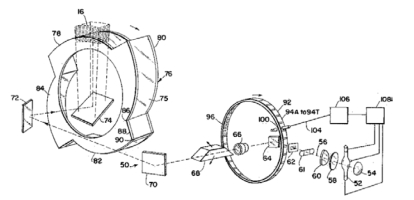
|


|

|
Either scroll down to view the complete Hall of Fame or choose the type:
The Felix3D Team has spent a lot of time researching the history of volumetric imaging. Nevertheless we ask you to help us by completing this Hall of Fame, so please send us descriptions and pictures of yet unknown (or here only preliminary stated) experimental setups or prototypes. We would be glad for any new descriptions and if possible one photo of the display and one of the researching team.
swept volume techniques
a) flat surface display
b) curved surface display
c) oscillating screen display
static volume techniques
d) solid state display
e) gaseous state display
other techniques
f) miscellaneous display type
Curved surface swept volume displays


|
 Apparatus for forming three dimensional images
Apparatus for forming three dimensional images
Leighton Homer Surbeck
1940
|
|
|
|
|


|
 Spherical Spiral Display
Spherical Spiral Display
D.W. Perkins
1962
|
An early approach using a curved moving surface was described in 1962 by D. W. Perkins. He introduced the "sphericalspiral display" with a specially shaped screen that rotates about its vertical axis and onto which a light beam is projected from below by an optical system The intention was to use it as a 3D radar display.
In the early 60s D. Perkins suggested a "Spherical Spiral Display" which is matched to radar-type 3D inputs. Like the sphere, the spherical spiral is the locus of circles with a common center and distributed about an axis that is the diameter of all the circles. In addition, each circle of the spherical spiral has a radius directly proportional to its angular position above the common axis. As the developed figure is rotated about its vertical axis at a constant velocity, the radius of the surface intersection with a plane containing the axis varies linearly with time. A small, high-intensity light source projects a collimated beam through a simple optical system onto manually controlled mirrors at the display center. The mirrors direct the beam to any azimuth and elevation. There is a fixed, mechanical shutter with three slits, so that three separate targets can be displayed on common azimuth and elevation angles.
N.N., "3-D display", Space/Aeronautics, pp. 60-67, Sept. 1962.
|
|
|
|


|
 Cathode Ray Tube For Three-Dimensional Presentations
Cathode Ray Tube For Three-Dimensional Presentations
Skellett, Albert M.
1965
|
|
|
|
|


|
 Synthalizer
Synthalizer
de Montebello
1969
|
Another space-filling display method is the "Synthalizer" invented by de Montebello in 1969. Images on a film strip are projected onto a rotating translucent drum which is composed of elements in the shape of an Archimedes' Spiral Instead of using a spiral, de Montebello alternatively proposed to use a projection screen in the form of a helix that rotates around its vertical axis.
Synthalizer - projection on a rotating Archimedes' spiral.
R. L. de Montebello, "Optical Dissector", U.S. Patent No. 3,428,393, 1969.
|
|
|
|


|
 Strobed Images on Rotating Helical Screen
Strobed Images on Rotating Helical Screen
W.D.Chase
1976
|
A 1976 patent issued to W. Chase uses a series of helically stepped pie-shaped glas sections where frames of strobed images are projected on.8 While rotating, the projection plane moves stepwise in depth. For a continuous movement he suggested to employ a smooth helical screen.
|
|
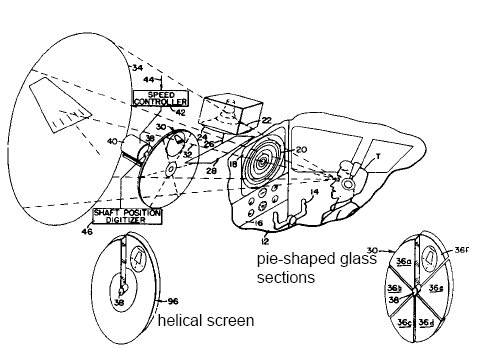
|
|
Fig. 1: Strobed images projected on a rotating helical screen
|
|
|
|


|
 Archimedes Spiral
Archimedes Spiral
H. Yamada
1986
|
|
|
|
|


|
 OmniView
OmniView
R.D. Williams, F.Gracia
1988
|
In 1988 R. D. Williams and F. Garcia demonstrated a display wherein a scanned laser beam is displayed upon a continuously rotating disc that is mounted on a motor shaft at an angle. Later they also employed a helical surface in their device further known as the OmniView 3D Display.
|
|
|
|


|
 Three_Dimensional Display System
Three_Dimensional Display System
Morton, Roger R. A.
1990
|
A system that is able to display an object in three dimensions and an accompanying method for use therein. Specifically, through this system, a three-dimensional image is displayed as a series of segments, e.g. line segments, formed by intersecting those surfaces of an object that are visible to a viewer with a sequence of pre-defined parallel helical surfaces taken through the object, with substantially the same pitch and axial orientation as that of a rotating helical reflector. Each dot in a resulting segment is then projected through both a focusing lens and an anamorphic lens onto a spatially corresponding portion of the rotating helical reflector. The anamorphic lens, which rotates in unison with the helical reflector, ensures, in conjunction with the focusing lens, that each dot will be focused on a given point along the reflector. By painting each such segment on a different portion of the reflector, the reflector, as it rotates, will sweep out a focused displayed volume. As a result and due to the persistence associated with human vision, a three-dimensional self-radiant "ghost-like" image of the object will appear to be displayed about the central (longitudinal) axis of the reflector. As fewer intersecting segments are painted on each rotation of the reflector, the image will increasingly appear as a "wire-frame" outline of the contours and edges of the object. However, as the number of such segments painted on the reflector increases per each rotation thereof, the three-dimensional image of the object will increasingly appear to "fill in". The displayed image contains appropriate visual information, such as stereoscopic, parallax and focus affects, such that it provides a relatively accurate three-dimensional depiction of the object.
|
|
|
|


|
 Laser Projected 3-D Volumetric Display
Laser Projected 3-D Volumetric Display
P. Soltan, M.Lasher et.al
1992
San Jose
USA
|
Since early 1990 a research team (P. Soltan, M. Lasher et.al.) at NRaD, the RDT&E Division of the Naval Command, Control and Ocean Surveillance Center (NCCOSC, San Diego), works on the development of laser-based volumetric 3D displays also based on a helical surface. Reflective and translucent screens have been investigated. One main research result was the development of a novel high performance acousto-optic scanning system leading to higher image resolutions. This was achieved in cooperation with NEOS Technologies who also work on a similar 3D display device.
|
|
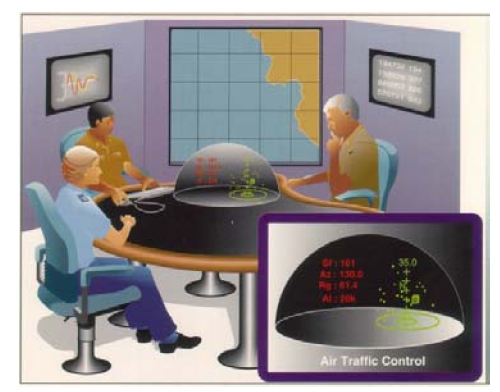
|
|
Fig. 1: Vision by the Naval Research Centre
|
|
|
|


|
 System and method for rotational scanner based volume display
System and method for rotational scanner based volume display
Anderson; Douglas W.
1995
|
A three dimensional display having a rotating screen, preferably helical in shape, a light source providing a beam of light and a holographic pattern deflecting the beam of light to predetermined points on the screen. The light is modulated, preferably by the holographic pattern. The holographic pattern rotates with the same angular velocity as the screen. The holographic pattern comprises a plurality of concentric circles, each of the circles comprising a plurality of cells, each of the cells representing a point on the screen.
|
|
|
|


|
 Laser based 3D volumetric display system
Laser based 3D volumetric display system
Soltan et al.
1998
|
A system for generating three dimensional images includes a data processor which generates a first data stream representing coordinates along a first axis, a second data stream representing coordinates along a second axis, and a third data stream representing intensities of optical beams. A demultiplexer transforms the first, second, and third data streams into multiple control signals each comprised of elements of the first, second and third data streams. The system further includes an optical energy source for generating an optical signal, and an optical beam steering system which divides the optical signal into multiple optical beams which are individually deflected and intensity modulated under the control of one of the control signals. The optical beams then are recombined and steered to reflect off the reflecting surface of a reflective structure, resulting in the presentation of a 3D image.
|
|
|
|


|
 Method and apparatus for high resolution three dimensional display
Method and apparatus for high resolution three dimensional display
Geng, Zheng Jason
2000
|
A process and system for displaying large (more than 1 million voxels) volumetric 3D images gives substantially higher resolution than is achievable with prior art techniques. The process and system utilize a sequence of helical slices of a 3D data set to generate a series of 2D images on a reflective surface of a light modulator. The series of 2D images generated on the light modulator are projected into a volumetric 3D-space display using an illumination light source and projection optics. Voxels in 3D space are illuminated for each 2D projected image, each voxel being located at its corresponding spatial location such that the 3D image thus generated can be viewed from any angle in a walkaround fish-tank manner without utilizing any viewing aids.
|
|
|
|


|
 Rotating display device and method for producing a three-dimensional real image
Rotating display device and method for producing a three-dimensional real image
Brotz, Gregory R
2000
|
A display device and method for producing a three-dimensional visual effect having a viewing area with a front and a depth with a rotating spiral screen disposed within the viewing area with the screen facing the front of the viewing area. A plurality of independently controlled light-producing elements are disposed on the spiral screen. Computerized image programs control the activation of selected of the plurality of light-producing elements in a desired pattern. The rotating spiral screen can also be a television screen.
|
|
|
|
|
|
|


